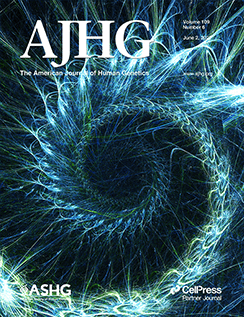Applying multimodal AI to physiological waveforms improves genetic prediction of cardiovascular traits
IF 8.1
1区 生物学
Q1 GENETICS & HEREDITY
引用次数: 0
Abstract
Electronic health records, biobanks, and wearable biosensors enable the collection of multiple health modalities from many individuals. Access to multimodal health data provides a unique opportunity for genetic studies of complex traits because different modalities relevant to a single physiological system (e.g., circulatory system) encode complementary and overlapping information. We propose a multimodal deep learning method, multimodal representation learning for genetic discovery on low-dimensional embeddings (M-REGLE), for discovering genetic associations from a joint representation of complementary electrophysiological waveform modalities. M-REGLE jointly learns a lower representation (i.e., latent factors) of multimodal physiological waveforms using a convolutional variational autoencoder, performs genome-wide association studies (GWASs) on each latent factor, then combines the results to study the genetics of the underlying system. To validate the advantages of M-REGLE and multimodal learning, we apply it to common cardiovascular modalities (photoplethysmogram [PPG] and electrocardiogram [ECG]) and compare its results to unimodal learning methods in which representations are learned from each data modality separately but are statistically combined for downstream genetic comparison. M-REGLE identifies 19.3% more loci on the 12-lead ECG dataset, 13.0% more loci on the ECG lead I + PPG dataset, and its genetic risk score significantly outperforms the unimodal risk score at predicting cardiac phenotypes, such as atrial fibrillation (Afib), in multiple biobanks.将多模态人工智能应用于生理波形可以改善心血管特征的遗传预测
电子健康记录、生物银行和可穿戴生物传感器能够收集许多个人的多种健康模式。获取多模式健康数据为复杂性状的遗传研究提供了独特的机会,因为与单一生理系统(如循环系统)相关的不同模式编码了互补和重叠的信息。我们提出了一种多模态深度学习方法,即用于低维嵌入遗传发现的多模态表示学习(M-REGLE),用于从互补电生理波形模式的联合表示中发现遗传关联。M-REGLE使用卷积变分自编码器共同学习多模态生理波形的较低表示(即潜在因素),对每个潜在因素进行全基因组关联研究(GWASs),然后将结果结合起来研究潜在系统的遗传学。为了验证M-REGLE和多模态学习的优势,我们将其应用于常见的心血管模式(光体积描记图[PPG]和心电图[ECG]),并将其结果与单模态学习方法进行比较,单模态学习方法分别从每个数据模式中学习表征,但在下游遗传比较中进行统计组合。M-REGLE在12导联心电图数据集中多识别19.3%的基因座,在ECG导联I + PPG数据集中多识别13.0%的基因座,其遗传风险评分在多个生物库中预测心脏表型(如心房颤动(Afib))方面显著优于单峰风险评分。
本文章由计算机程序翻译,如有差异,请以英文原文为准。
求助全文
约1分钟内获得全文
求助全文
来源期刊
CiteScore
14.70
自引率
4.10%
发文量
185
审稿时长
1 months
期刊介绍:
The American Journal of Human Genetics (AJHG) is a monthly journal published by Cell Press, chosen by The American Society of Human Genetics (ASHG) as its premier publication starting from January 2008. AJHG represents Cell Press's first society-owned journal, and both ASHG and Cell Press anticipate significant synergies between AJHG content and that of other Cell Press titles.

 求助内容:
求助内容: 应助结果提醒方式:
应助结果提醒方式:


